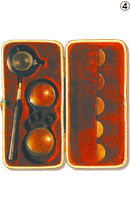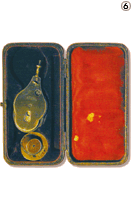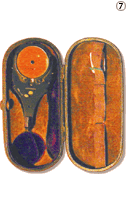The ophthalmoscope
The ophthalmoscope is an optical instrument that makes a thin beam of light pass through the pupil, so as to allow the sight of the retina. Herman Helmholz (1821-1899) invented the ophthalmoscope in 1850. A diversity of ophthalmoscopes was manufactured since then. In the Museum Maximiano Lemos of the History of Medicine there are specimens of the ophthalmoscope of Galezowsky, Parent, Plácido, Liebreich, Landolt, May and Universal among the most significant.
|
|
1 - Wooden case with leather and velvet dressing (4,5x6,5x13,5cm).
Has the inscription "D.A.".
Ophthalmoscope: Bone, golden steel and glass; 19th century; 12x4x4cm.
2 - Ophthalmoscope: Wood, steel and glass; 19th century; 13x2,4x3,5cm.
Donation from the Physiology Service.
3 - Ophthalmoscope of Galezowski: Steel, glass and skin; 19th century; 6x21,5x4cm.
Belonged to Professor Plácido da Costa.
Has the inscription "Ophtalmoscope du Dr. Galezowski - Robert & Collin, Paris, nº 955, Breveté".
Donation from the Physiology Service.
4 - Wooden case with leather and crimson velvet dressing (2,2x14,3x6,8cm).
Ophthalmoscope of Liebreich: Steel, glass and plastic; 19th century; 13x4x0,9cm.
5 - Ophthalmoscope of Plácido: Tortoiseshell, brass and glass; 1880; 5,4x3,7x2,5cm.
The first one manufactured in Portugal.
Donation from the Physiology Service.
6 - Wooden case with leather, velvet and silk dressing (2x13x6,5cm).
Two parts of the oftalmoscope of Parent: Steel, brass and glass; 20th century; Giroux, Paris.
7 - Wooden case with leather and lilac velvet dressing (2,2x14,3x6,8cm).
Refraction ophthalmoscope of Landolt: Ivory, steel, brass and glass; 19th century; 16,6x3,7x1cm.
|









